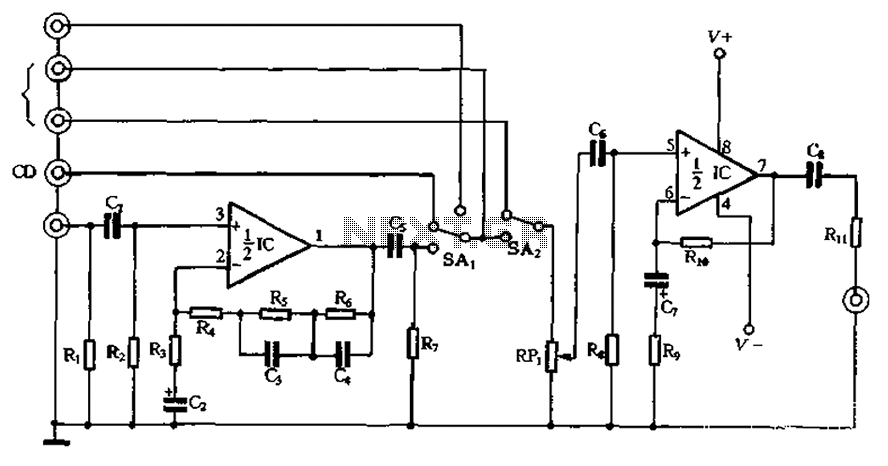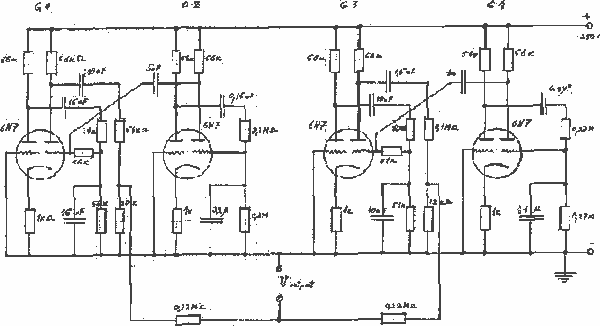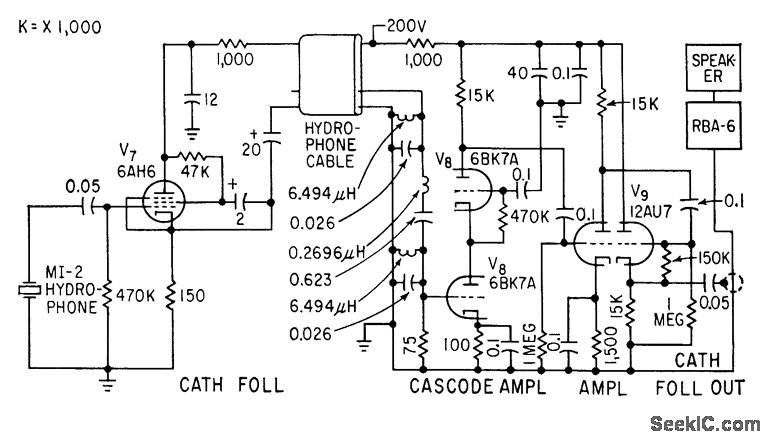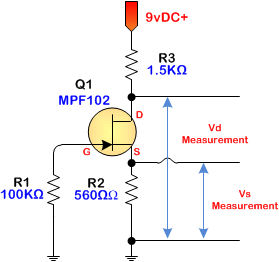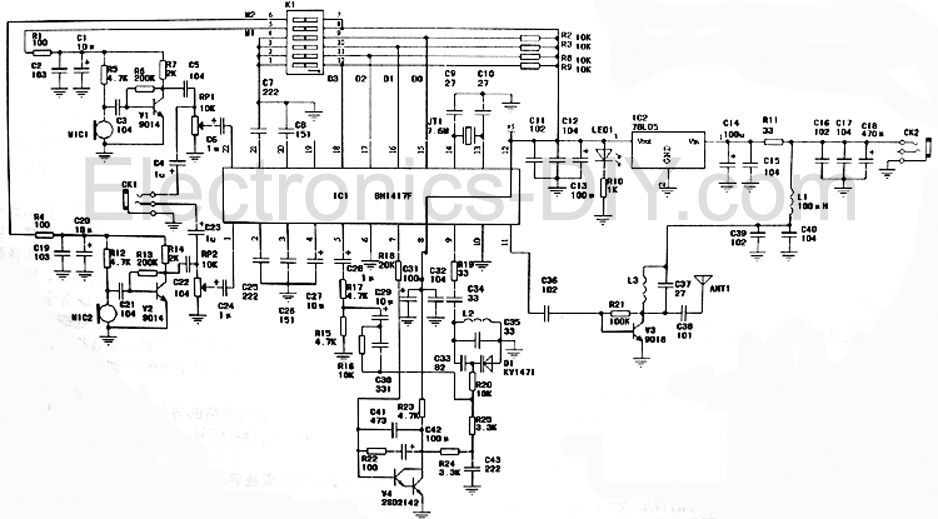
Valve high-gain stereo preamp
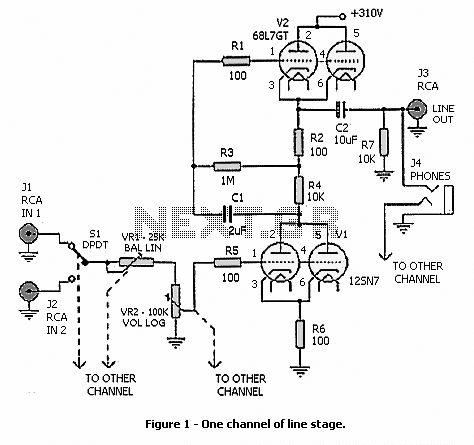
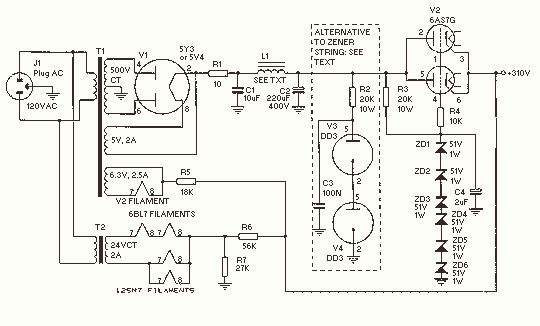
A cathode follower based on the 6BL7 or 6BX7 is ideal for output. I used a mu-follower circuit with no feedback, a 12SN7 as the gain stage, and a 6BL7 as the cathode follower/current source. You might argue that the current source should be a pentode of highest possible gain, but pentodes can be noisy, and one of my design goals was minimalism. The line stage is a straightforward mu follower, with medium-mu triode 12SN7GT below and low-mu triode 6BL7GT above. I paralleled both sides of each tube for maximum lifetime and for minimum output impedance. I chose resistors from my junk box, so there is nothing sacred about the values shown.
The circuit employs a cathode follower configuration utilizing the 6BL7 or 6BX7 tubes, which are well-suited for output applications due to their low output impedance and ability to drive loads effectively. The design features a mu-follower circuit without feedback, using a 12SN7 as the gain stage. The choice of a 12SN7, a medium-mu triode, allows for sufficient gain while maintaining linearity. The 6BL7, functioning as the cathode follower and current source, provides a low output impedance that is beneficial for driving subsequent stages or loads.
In the implementation, both sides of each tube are paralleled to enhance reliability and extend the operational lifespan of the components. This configuration also aids in reducing output impedance, which is crucial for maintaining signal integrity over varying load conditions. The use of resistors from a collection allows for flexibility in component selection, although it is advisable to choose resistor values that align with the desired frequency response and gain characteristics of the circuit.
The output stage includes a 10µF capacitor, which is calculated to provide a -3dB low-frequency cutoff of approximately 26.5Hz when interfaced with a 600-ohm load. This ensures that the circuit maintains a solid bass response while filtering out unwanted low-frequency noise. The construction method can be point-to-point on ceramic terminal strips, which are advantageous for their durability and ease of assembly.
The circuit can accommodate various tube combinations, allowing for experimentation with different configurations. Alternatives to the 12SN7 for the lower tube include the 6J5, 12SX7, 6CG7, or 12AU7, while the upper tube can be replaced with options like the 6BX7 or triode-connected 6BQ5. The use of miniature dual triodes such as the 6DE7 or 6EW7 is also viable, though octal tubes are generally preferred for their superior audio performance.
The inclusion of a four-section Alps volume control enhances user interface and control over the audio output. The design features dual stereo inputs, selectable via a DPDT switch, with all RCA jacks positioned on the top of the chassis for convenient access. The layout minimizes signal path lengths, reducing potential interference and maintaining signal quality.
Overall, this circuit design emphasizes simplicity and effectiveness, leveraging the characteristics of the chosen tubes to achieve high-quality audio performance while maintaining a minimalist approach.A cathode follower based on the 6BL7 or 6BX7 is ideal for output. I used a mu-follower circuit with no feedback, a 12SN7 as the gain stage, and a 6BL7 as the cathode follower/current source. (I have many old GEs I wanted to use, and converting to 6SN7 means simply changing the hookup to the 24V filament transformer).
You might argue that the current source should be a pentode of highest possible gain, but pentodes can be noisy, and one of my design goals was minimalism. The line stage (Fig. 1) is a straightforward mu follower, with medium-mu triode 12SN7GT below and low-mu triode 6BL7GT above.
I paralleled both sides of each tube for maximum lifetime and for minimum output impedance. I chose resistors from my junk box, so there is nothing sacred about the values shown. I have many opportunities to experiment with other equipment. I have tried innumerable preamps based on 12AX7 and 6DJ8 types, including Dynaco PAS-3s with every modification imaginable; McIntosh C11, C20, and C22; Scott 130; various Audio Research units; old NYAL Minuets; Lafayette KT-600 (probably the best of the vintage units); and some home-brews. Not one of them had the real magic. In my opinion, most 12AX7s have a "lumpy" sound and do not maintain similar frequency response between channels, because negative feedback tends to "amplify" response aberrations, especially when tubes age and drift.
The 6DJ8s have a wiry, irritating sound to me. I believe that some listeners confuse this kind of distortion with extreme sonic detail. Although probably the best of the manufactured preamps, the old MFA Luminescence (currently out of production) isn't perfect. It is too complex, the phono stage is a bit of a monstrosity, and the line stage uses unnecessary negative feedback.
It uses all octal-based tubes, which tend to produce better sound than similar miniature types. Maybe octals have a less microphonic character, but of a more pleasing type. Two of my acquaintances, who each have a Luminescence, both complain about the unit running too hot to touch. And the line stages drift, so they often must look for closely matched 6DN7s. Also, the 7591 in the power supply and all the 5691s in the phono stage add to the expense of keeping this unit running.
(As a substitute for the 5691s, Luminescence owners could try 6SL7s, which work just as well and at a fraction of the price.) The 10F capacitor on the output was calculated to give a -3dB low-frequency cutoff of 26.5Hz when working into a 600 load. You can build all the circuitry point-to-point on ceramic terminal strips of the type from old "junker" Tektronix tube oscilloscopes (mine were surplus NOS) or from Triode Electronics.
All the sockets are premium ceramic octals with silver contacts. You probably don't need DC for the filaments, because the filament wiring is run inside grounded copper shield braid right up to the sockets. This circuit should work fine with a 6J5, 12SX7, 6CG7, or 12AU7 as the lower tube, and a 6BX7, 12B4, or triode-connected 6BQ5 as the upper tube.
Any of the miniature TV dual triodes such as 6DE7 or 6EW7 can serve as both top and bottom triodes since they contain a medium-mu and a low-mu section. (This wouldn't be my choice, since the octals seem to sound better, but you may choose the tubes you like.) I rescued a four-section Alps volume control from a scrapped Kenwood amp as a potentiometer.
It is very similar to the Old Colony unit. The center shaft is volume, and the outer ring is a balance trimmer. I provided two stereo inputs, selected with a DPDT switch. All the RCA jacks are on top of the chassis, very close to the audio circuits to allow for minimum path lengths and easier cable hook-up (I hate reaching around behind components to mess with interconnects). Heat from the tubes is not the problem you might think; I laid a cable on top of a 6BL7 for eight hours (they run hot), and the insulation didn't soften.
I believe octal tubes are the best choice. It is difficult to beat a good 6SN7 for audible excellence at a low price. You can use other tubes, but for both present and future availability, the SN is tops. It's like an old friend who doesn't let you down. Even the Russian versions sound better to me than any 12AU7. 🔗 External reference
The circuit employs a cathode follower configuration utilizing the 6BL7 or 6BX7 tubes, which are well-suited for output applications due to their low output impedance and ability to drive loads effectively. The design features a mu-follower circuit without feedback, using a 12SN7 as the gain stage. The choice of a 12SN7, a medium-mu triode, allows for sufficient gain while maintaining linearity. The 6BL7, functioning as the cathode follower and current source, provides a low output impedance that is beneficial for driving subsequent stages or loads.
In the implementation, both sides of each tube are paralleled to enhance reliability and extend the operational lifespan of the components. This configuration also aids in reducing output impedance, which is crucial for maintaining signal integrity over varying load conditions. The use of resistors from a collection allows for flexibility in component selection, although it is advisable to choose resistor values that align with the desired frequency response and gain characteristics of the circuit.
The output stage includes a 10µF capacitor, which is calculated to provide a -3dB low-frequency cutoff of approximately 26.5Hz when interfaced with a 600-ohm load. This ensures that the circuit maintains a solid bass response while filtering out unwanted low-frequency noise. The construction method can be point-to-point on ceramic terminal strips, which are advantageous for their durability and ease of assembly.
The circuit can accommodate various tube combinations, allowing for experimentation with different configurations. Alternatives to the 12SN7 for the lower tube include the 6J5, 12SX7, 6CG7, or 12AU7, while the upper tube can be replaced with options like the 6BX7 or triode-connected 6BQ5. The use of miniature dual triodes such as the 6DE7 or 6EW7 is also viable, though octal tubes are generally preferred for their superior audio performance.
The inclusion of a four-section Alps volume control enhances user interface and control over the audio output. The design features dual stereo inputs, selectable via a DPDT switch, with all RCA jacks positioned on the top of the chassis for convenient access. The layout minimizes signal path lengths, reducing potential interference and maintaining signal quality.
Overall, this circuit design emphasizes simplicity and effectiveness, leveraging the characteristics of the chosen tubes to achieve high-quality audio performance while maintaining a minimalist approach.A cathode follower based on the 6BL7 or 6BX7 is ideal for output. I used a mu-follower circuit with no feedback, a 12SN7 as the gain stage, and a 6BL7 as the cathode follower/current source. (I have many old GEs I wanted to use, and converting to 6SN7 means simply changing the hookup to the 24V filament transformer).
You might argue that the current source should be a pentode of highest possible gain, but pentodes can be noisy, and one of my design goals was minimalism. The line stage (Fig. 1) is a straightforward mu follower, with medium-mu triode 12SN7GT below and low-mu triode 6BL7GT above.
I paralleled both sides of each tube for maximum lifetime and for minimum output impedance. I chose resistors from my junk box, so there is nothing sacred about the values shown. I have many opportunities to experiment with other equipment. I have tried innumerable preamps based on 12AX7 and 6DJ8 types, including Dynaco PAS-3s with every modification imaginable; McIntosh C11, C20, and C22; Scott 130; various Audio Research units; old NYAL Minuets; Lafayette KT-600 (probably the best of the vintage units); and some home-brews. Not one of them had the real magic. In my opinion, most 12AX7s have a "lumpy" sound and do not maintain similar frequency response between channels, because negative feedback tends to "amplify" response aberrations, especially when tubes age and drift.
The 6DJ8s have a wiry, irritating sound to me. I believe that some listeners confuse this kind of distortion with extreme sonic detail. Although probably the best of the manufactured preamps, the old MFA Luminescence (currently out of production) isn't perfect. It is too complex, the phono stage is a bit of a monstrosity, and the line stage uses unnecessary negative feedback.
It uses all octal-based tubes, which tend to produce better sound than similar miniature types. Maybe octals have a less microphonic character, but of a more pleasing type. Two of my acquaintances, who each have a Luminescence, both complain about the unit running too hot to touch. And the line stages drift, so they often must look for closely matched 6DN7s. Also, the 7591 in the power supply and all the 5691s in the phono stage add to the expense of keeping this unit running.
(As a substitute for the 5691s, Luminescence owners could try 6SL7s, which work just as well and at a fraction of the price.) The 10F capacitor on the output was calculated to give a -3dB low-frequency cutoff of 26.5Hz when working into a 600 load. You can build all the circuitry point-to-point on ceramic terminal strips of the type from old "junker" Tektronix tube oscilloscopes (mine were surplus NOS) or from Triode Electronics.
All the sockets are premium ceramic octals with silver contacts. You probably don't need DC for the filaments, because the filament wiring is run inside grounded copper shield braid right up to the sockets. This circuit should work fine with a 6J5, 12SX7, 6CG7, or 12AU7 as the lower tube, and a 6BX7, 12B4, or triode-connected 6BQ5 as the upper tube.
Any of the miniature TV dual triodes such as 6DE7 or 6EW7 can serve as both top and bottom triodes since they contain a medium-mu and a low-mu section. (This wouldn't be my choice, since the octals seem to sound better, but you may choose the tubes you like.) I rescued a four-section Alps volume control from a scrapped Kenwood amp as a potentiometer.
It is very similar to the Old Colony unit. The center shaft is volume, and the outer ring is a balance trimmer. I provided two stereo inputs, selected with a DPDT switch. All the RCA jacks are on top of the chassis, very close to the audio circuits to allow for minimum path lengths and easier cable hook-up (I hate reaching around behind components to mess with interconnects). Heat from the tubes is not the problem you might think; I laid a cable on top of a 6BL7 for eight hours (they run hot), and the insulation didn't soften.
I believe octal tubes are the best choice. It is difficult to beat a good 6SN7 for audible excellence at a low price. You can use other tubes, but for both present and future availability, the SN is tops. It's like an old friend who doesn't let you down. Even the Russian versions sound better to me than any 12AU7. 🔗 External reference
Warning: include(partials/cookie-banner.php): Failed to open stream: Permission denied in /var/www/html/nextgr/view-circuit.php on line 713
Warning: include(): Failed opening 'partials/cookie-banner.php' for inclusion (include_path='.:/usr/share/php') in /var/www/html/nextgr/view-circuit.php on line 713
